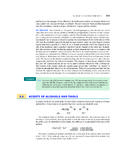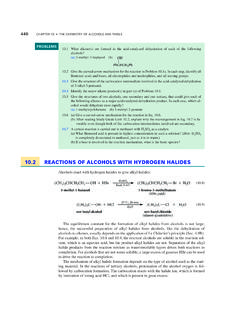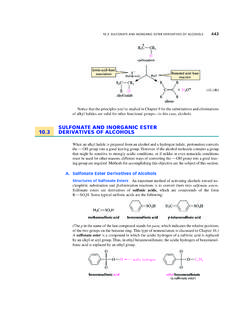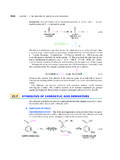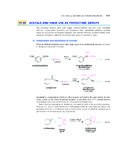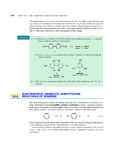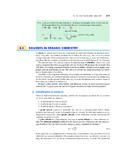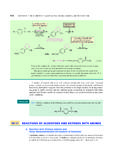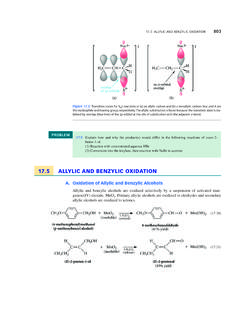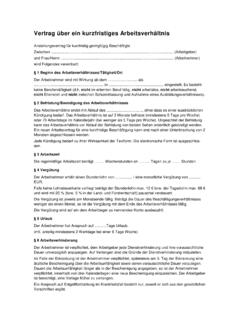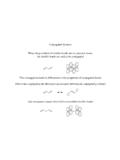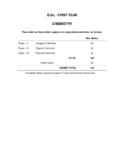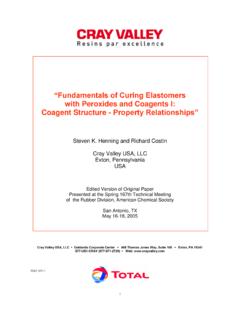Transcription of 1226 CHAPTER 25 • THE CHEMISTRY OF THE AROMATIC …
1 1226 CHAPTER 25 THE CHEMISTRY OF THE AROMATIC HETEROCYCLESB. Acidity of Pyrrole and Indole Pyrrole and indole are weak pKavalues of about , pyrrole and indole are about as acidic as alcohols and about15 17 pKaunits more acidic than primary and secondary amines (Sec. ). The greateracidity of pyrroles and indoles is a consequence of the resonance stabilization of theirconjugate-base anions (Eq. ; draw the three missing resonance structures in this equation.)Pyrrole and indole are rapidly deprotonated byGrignard and organolithium (a)Suggest a reason why pyridine is miscible with water, whereas pyrrole has little water sol-ubility.(b) Indicate whether you would expect imidazole to have high or low water solubility, (a)The compound 4-(dimethylamino)pyridine protonates to give a conjugate acid with a pKavalue of This compound is thus pKaunits more basic than pyridine itself.
2 Drawthe structure of the conjugate acid of 4-(dimethylamino)pyridine, and explain why 4-(di-methylamino)pyridine is much more basic than pyridine.(b) What product is expected when 4-(dimethylamino)pyridine reacts with CH3I? of aniline causes a dramatic shift of its UV spectrum to lower wavelengths, butprotonation of pyridine has almost no effect on its UV spectrum. Explain the CHEMISTRY OF FURAN, PYRROLE, AND THIOPHENEA. Electrophilic AROMATIC SubstitutionFuran, thiophene, and pyrrole, like benzene and naphthalene, undergo electrophilic aromaticsubstitution reactions. Let s try to predict the ring carbon at which substitution occurs in thesecompounds by examining the carbocation intermediates involved in the substitution reactionsat the two different positions and applying Hammond s postulate.( )NH"NMgBr"+CH3CH2+CH3CH3 MgBrL( )NH(a base)1"N11+B3_+ Exploration Acidities of1,3-Cyclopentadieneand Pyrrole 12/5/08 11:48 AM Page THE CHEMISTRY OF FURAN, PYRROLE, AND THIOPHENE1227 Study Problem the nitration of pyrrole as an example, predict whether electrophilic AROMATIC substitutionoccurs predominantly at carbon-2 or (p.)
3 755) that the electrophile in nitration is the nitronium ion, | at the two different positions of pyrrole by the nitronium ion gives differentcarbocation intermediates:Substitution at carbon-2:Substitution at carbon-3:The carbocation resulting from substitution at carbon-2 has more important resonance structuresand is therefore more stable than the carbocation resulting from substitution at carbon-3. ApplyingHammond s postulate, we predict that the reaction involving the more stable intermediate shouldbe the faster reaction. Consequently, nitration should occur at carbon-2. The experimental factsare as follows:2-Nitropyrrole is the major nitration product of pyrrole, as predicted. Nothing is really wrong withsubstitution at carbon-3; substitution at carbon-2 is simply more favorable. As Eq. shows,some 3-nitropyrrole is obtained in the Study Problem suggests, electrophilic substitution of pyrrole occurs predomi-nantly at the 2-position.
4 Similar results are observed with furan and thiophene:( )S+++HNO3H2 Oacetic anhydrideNO2L(70% yield)"NO2(5% yield)SS( )BF3CH3CO2HO+H3 CCLCH3 LOLCLSOSO(a Friedel Crafts reaction)+H3 CCLOHLSOCH3 LCLSO(75 92% yield)O( )HN"+++HNO3H2O20 Cacetic anhydrideNO2HN"L(50% yield)HN""NO2(15% yield)( )""HN"H2NO2|HN""H2|NO2""HNO2HN|"( )HN""H2|NO2 HNO2""HN|"HN"H2NO2""|HNO2""HN"2| 12/5/08 11:48 AM Page 12271228 CHAPTER 25 THE CHEMISTRY OF THE AROMATIC HETEROCYCLESP yrrole, furan, and thiophene are all much more reactive than benzene in electrophilic aro-matic substitution. Although precise reactivity ratios depend on the particular reaction, the rel-ative rates of bromination are typical:Milder reaction conditions must be used with more reactive compounds. (Reaction condi-tions that are too vigorous in many cases bring about so many side reactions that polymerizationand tar formation occur.)
5 For example, a less reactive acylating reagent is used in the acylationof furan than in the acylation of benzene. (Recall that anhydrides are less reactive than acid chlo-rides; pp. 1011 1015.)The reactivity order of the heterocycles (Eq. ) is a consequence of the relative abili-ties of the heteroatoms to stabilize positive charge in the intermediate carbocations (as in , for example). Both pyrrole and furan have heteroatoms from the second period of theperiodic table. Because nitrogen is better than oxygen at delocalizing positive charge nitro-gen is less electronegative pyrrole is more reactive than furan. The sulfur of thiophene is athird-period element and, although it is less electronegative than oxygen, its 3porbitals over-lap less efficiently with the 2porbitals of the AROMATIC p-electron system (see Fig. , ). In fact, the reactivity orderof the heterocycles in AROMATIC substitution parallels the re-activity order of the correspondingly substituted benzene derivatives:Relative reactivities:When we consider the activating and directing effects of substituents in furan, pyrrole, andthiophene rings, the usual activating and directing effects of substituents in AROMATIC substitu-tion apply (see Table , p.)
6 763). Superimposed on these effects is the normal effect of theheterocyclic atom in directing substitution to the 2-position. The following example illustratesthese effects:( )Br2 AcOH"CO2H3-thiophenecarboxylic acid5-bromo-3-thiophenecarboxylic acid(69% yield; satisfies the directing effect ofboth the heteroatom and LCO2H)BrL"CO2H meta (1,3)SSBr"CO2 HLS(not observed; satisfies the directing effect ofthe heteroatom only)( )>>(CH3)2NL2N,N-dimethylanilineCH3OL22an isoleCH3SL22thioanisole( )BF3 AcOH+H3 CCLCH3 LOLCLSOSO+H3 CCLOHLSOCH3 LCLSO(75 92% yield)OO( )1) AlCl32) H2O+H3 CCLClLSO(97% yield)+HClCLCH3 LSO( )pyrrole3 X 1018furan6 X 1011thiophene5 X 109benzene1>>> 12/5/08 11:48 AM Page THE CHEMISTRY OF FURAN, PYRROLE, AND THIOPHENE1229In this example, the LCO2H group directs the second substituent into a meta (1,3) relation-ship; the thiophene ring tends to substitute at the 2-position.
7 The observed product satisfiesboth of these directing effects. (Notice that we count around the carbonframework of the het-erocyclic compound, not through the heteroatom, when using this ortho, meta, para analogy.)In the following example, the chloro group is an ortho, para-directing group. Because the po-sition para to the chloro group is also a 2-position, both the sulfur of the ring and the chlorogroup direct the incoming nitro group to the same the directing effects of substituents and the ring compete, it is not unusual to observemixtures of , if both 2-positions are occupied, 3-substitution takes Addition Reactions of FuranThe previous sections focused on the AROMATIC character of furan, pyrrole, and thiophene. Afuran, pyrrole, or thiophene could, however, be viewed as a 1,3-butadiene with its terminalcarbons tied down by a heteroatom the heterocycles ever behave chemically as if they are conjugated dienes?
8 Of the threeheterocyclic compounds furan, pyrrole, and thiophene, furan has the least resonance energy(Table ) and, by implication, the least AROMATIC character. Consequently, of the three com-pounds, furan has the greatest tendency to behave like a conjugated diene . butadiene unit within furanO( )BF3 AcOH++H3 CCLCH3 LOLCLSOSOCH3 COHSOH3 CCH3 LCH3LL"CSO2,5-dimethylfuranacetic anhydride(65% yield)H3 CCH3 LLOO( )2,5-dinitrothiophene(44%)HNO30 C+(60% yield)the NO2 groupdirects herethe sulfurdirects here2,4-dinitrothiophene(56%)O2N"NO2 LSO2 NLNO2LS2-nitrothiopheneNO2LS( )HNO3Ac2O2-chlorothiopheneClL2-chloro-5- nitrothiophene(57% yield)ClLO2NL para (1,4) 12/5/08 11:48 AM Page 12291230 CHAPTER 25 THE CHEMISTRY OF THE AROMATIC HETEROCYCLESOne characteristic reaction of conjugated dienes is conjugate addition(Sec. ). In-deed, furan does undergo some conjugate addition reactions.
9 One example of such a reactionoccurs in bromination. For example, furan undergoes conjugate addition of bromine andmethanol in methanol solvent; the conjugate-addition product then undergoes an SN1 reactionwith the methanol. (Write mechanisms for both parts of this reaction; refer to Sec. ifnecessary.)Another manifestation of the conjugated- diene character of furan is that it undergoesDiels Alder reactions (Sec. ) with reactive dienophiles such as maleic Side-Chain ReactionsMany reactions occur at the side chains of heterocyclic compounds without affecting therings, just as some reactions occur at the side chain of a substituted benzene (Secs. ).A particularly useful example of a side-chain reaction is removal of a carboxy group directlyattached to the ring (decarboxylation). This reaction is effected by strong heating, in somecases with catalysts.
10 ( )+CO2heat200 C2-furancarboxylic acidOHLCLSOO furanHLO( )Ag2O(Sec. )3-thiophenecarboxylic acid(95 97% yield)"CO2HS3-thiophenecarbaldehyde"CHOA S( )+furanOOOSS maleic anhydride""OOOSSOHH(>90% yield)O( )++Br2CH3 OHCH3 OHmixture of stereoisomers(72 76% yield)HHBr"""HH"""CH3O+HBr+HBrOCH3""CH3 OOOOan SN1 reactiona 12/5/08 11:48 AM Page THE CHEMISTRY OF each of the following reactions by giving the principal organic product(s).(a)(b) (c)(d) a curved-arrow mechanism for the following CHEMISTRY OF PYRIDINEA. Electrophilic AROMATIC SubstitutionIn general, it is difficult to prepare monosubstituted pyridines by electrophilic AROMATIC substi-tution because pyridine has a very low reactivity; it is much less reactive than benzene. An im-portant reason for this low reactivity is that pyridine is protonated under the very acidic con-ditions of most electrophilic AROMATIC substitution reactions (Eq.)
